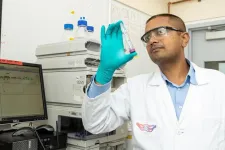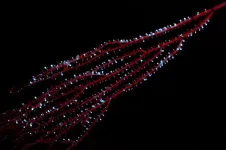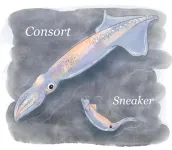(Press-News.org)
SRI announced today that it has been selected by the Defense Advanced Research Projects Agency (DARPA) to deliver advanced technology for its recently launched Multiobjective Engineering and Testing of ALloy Structures (METALS) program.
DARPA METALS aims to break today’s one-material-per-part paradigm, which can lead to vulnerabilities and reduced life when highly engineered components experience austere environments. The goal of the four-year program is to develop technologies that treat material selection – particularly metallic alloys – as a continuous variable in design that can be tailored across a single part.
SRI’s approach will radically expand the design space, enabling breakthroughs in system-level performance, cost, and sustainability. SRI and its collaborators will develop new ways to integrate materials into the design process and break new ground in rapid, intelligent testing for advanced material properties. SRI will leverage AI-based material informatics to inform design space exploration through testing.
The work is being led by researchers in SRI's Future Concepts division, previously known as the Palo Alto Research Center (PARC), and the team has been at the forefront of digital design and manufacturing research for more than a decade. SRI acquired PARC in April 2023, bringing together two innovation icons in Silicon Valley.
Today, designers have to work with a discrete selection of materials that are provided to them by material scientists that are not necessarily optimal for the specific needs of a component or application.
“There is no design tool that can vary materials in three-dimensional space while simultaneously accounting for metallurgical constraints,” said Morad Behandish, Research Director for Design and Digital Manufacturing at SRI and Principal Investigator on the project. “We’re building a design tool that will allow us to create components with desired properties on the fly, place them precisely where needed, test them in the environment in which they’ll be used, and envision new alloys that do not yet exist.”
Behandish added, “metal additive manufacturing allows us to make such components; however, predicting advanced long-term properties like fatigue, creep, and oxidation in high temperatures in a scalable way demands radical new ways of testing that we will develop in this project, unlocking the true potential of modern manufacturing and its adoption.”
SRI has teamed up with the University of Illinois Urbana-Champaign (UIUC) and the University of California San Diego (UCSD) to develop MIDAS-X: Material-Integrated Design with Agile Sampling for experimental testing. SRI’s capabilities in generative design exploration and AI, UIUC’s novel testing methods, and UCSD’s unique manufacturing capabilities make a strong team with a highly innovative approach. SRI aims to build design tools with an evolving understanding of materials feasibility grounded in rapid testing to make the best use of existing materials and discover new materials.
SRI’s system will change design shape and materials simultaneously to optimize for many factors and navigate a trade space of cost and time to build, structural and thermal performance, supply chain risks, and more. The system relies on a unique approach, based on UIUC’s recent discoveries, to predict advanced properties from nanoscale events observable under an electron microscope enabling orders of magnitude faster material characterization.
“This program marks a turning point in how we design, make, and validate materials at an exciting crossroads of innovation in computational design, materials science, digital manufacturing, and AI,” Behandish emphasized. “The biggest impact will be on high-end applications, especially when human life is trusted with engineered equipment, where the reliance on outdated engineering methods in current practice takes significant time and cost in design cycles and material systems adoption.”
About SRI
SRI is an independent nonprofit research institute headquartered in Menlo Park, California, with a rich history of supporting government and industry. We create and deliver world-changing solutions for a safer, healthier, and more sustainable future. For more than 75 years, we have collaborated across technical and scientific disciplines to discover and develop groundbreaking products and technologies and bring innovations and ideas to the marketplace. Learn more at www.sri.com.
Distribution Statement A: Approved for public release, distribution is unlimited.
###
END
Vaccines remain the gold standard of protection against dangerous pathogens, but take considerable time and vast resources to develop. Rapidly mutating viruses such as SARS-CoV-2 can blunt their effectiveness and even render them obsolete.
To address these gaps, a multi-university team led by New Jersey Institute of Technology’s Vivek Kumar is developing a hydrogel therapy that acts as a first line of defense against viruses and other biological threats. The peptides that make up this gel prevent viruses ...
WASHINGTON –Perinatal transmission of HIV to newborns is associated with serious cognitive deficits as children grow older, according to a detailed analysis of 35 studies conducted by Georgetown University Medical Center neuroscientists. The finding helps pinpoint the geographic regions and factors that may be important for brain development outcomes related to perinatal HIV infection: mother-to-child HIV transmission during pregnancy, labor and delivery, or breastfeeding.
The findings appeared in eClinicalMedicine on April 23, 2024.
Mostly because of advances in antiretroviral therapies, AIDS, which is caused by HIV infection, has ...
In Europe and North America, 30 to 60% of dietary energy intake in adults comes from ultra-processed foods. An increasing number of epidemiological studies suggest a link between higher consumption levels of ultra-processed foods with higher risks of diabetes and other metabolic disorders.
Emulsifiers are among the most commonly used additives. They are often added to processed and packaged foods such as certain industrial cakes, biscuits and desserts, as well as yoghurts, ice creams, chocolate bars, industrial breads, margarines and ready-to-eat or ready-to-heat meals, in order to improve their appearance, taste and texture and lengthen ...
Imagine being able to look inside a single cancer cell and see how it communicates with its neighbours.
Scientists are celebrating a new technique that lets them study the fatty contents of cancer cells, one by one.
A study led by the University of Surrey has sampled single live cancer cells and measured the fatty lipid compounds inside them. Working with partners at GSK and UCL, and developing new equipment with Yokogawa, the team saw how those cells transformed in response to changes in their environment.
Dr ...
Bioluminescence first evolved in animals at least 540 million years ago in a group of marine invertebrates called octocorals, according to the results of a new study from scientists with the Smithsonian’s National Museum of Natural History.
The results, published today, April 23, in the Proceedings of the Royal Society B, push back the previous record for the luminous trait’s oldest dated emergence in animals by nearly 300 million years, and could one day help scientists decode why the ability to produce light evolved in the first place.
Bioluminescence—the ability of living things to produce light via chemical reactions—has independently ...
The day a male spear squid hatches determines which mating tactic he will use throughout his life, according to new research. Spear squid (Heterololigo bleekeri) that hatch earlier in the season become “consorts” which fight for mating opportunities. Those which hatch later become “sneakers,” which use more clandestine mating tactics. Researchers found that the mating tactic determined by the birth date was fixed for the squid’s whole life. Understanding how mating tactics are influenced by birth date, and the environmental conditions at that time, can help researchers consider ...
Embargoed until 00:01am BST on Wednesday 24 April 2024/19.01pm ET on Tuesday 23 April 2024
-With pictures-
The Universe’s early galaxies were less chaotic and developed much faster than previously thought, according to new research looking back more than ten billion years in time.
An international team of astronomers led by Durham University, UK, used the James Webb Space Telescope (JWST) to find evidence of bar formation when the Universe was only a few billion years old.
Bars are elongated strips of stars found in disc or ...
RICHLAND, Wash.—There’s some irony in the fact that devices that seem indispensable to modern life—mobile phones, personal computers, and anything battery-powered—depend entirely on minerals extracted from mining, one of the most ancient of human industries. Once their usefulness is spent, we typically return these objects to the Earth in landfills, by the millions.
But what if we could “mine” electronic waste (e-waste), recovering the useful minerals contained within them, instead of throwing them away? A clever method of recovering valuable minerals from e-waste, developed by a research team at the Department ...
How do algorithms determine the way we interact with our memories?
It’s a uniquely 21st-century kind of question, and it is far from settled.
In a new paper in the journal Memory, Mind & Media, Concordia PhD candidate Chrys Vilvang argues that the way tech companies store, package and share personal content back to users is opaque. And, given one recent controversy, it’s open to important questions about selection and representation.
Vilvang’s paper looks at the discussion stemming from an April 2022 article on 9to5Mac, a tech news site dedicated to all things Apple. Its journalists were given access to the iOS 15.5 beta update, and they discovered ...
Image
University of Michigan researchers have developed a new tool to better understand how chemicals like dopamine and epinephrine interact with neurons.
These chemicals are among a wide variety of signals that get processed in the brain through G protein-coupled receptors (GPCRs), proteins that sit on the surface of neurons to receive messages—in the forms of proteins, sugars, fats, even light—that inform cellular behavior.
GPCRs are involved in an enormous number of biological functions, making them a prime ...





